A record number of travelers are set to travel within the country during the upcoming National Day and Mid-Autumn Festival vacation period, Yang Feiyue reports.
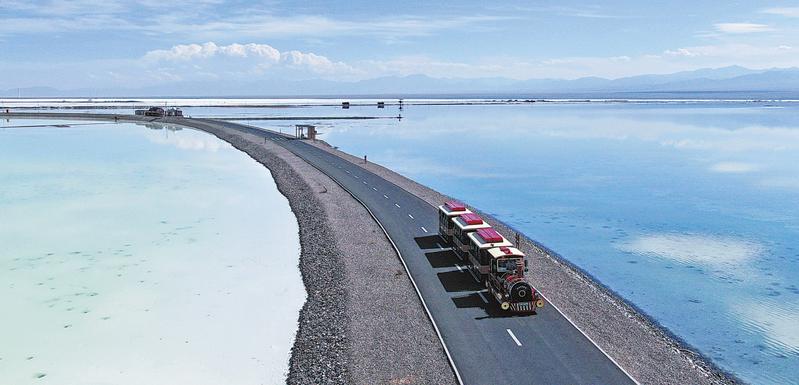 Visitors take a sightseeing train ride to explore the charm of Chaka Salt Lake, known as the "Mirror of the Sky", in Ulan county, Haixi Mongol and Tibetan autonomous prefecture, Qinghai province. (PHOTO PROVIDED TO CHINA DAILY)
Visitors take a sightseeing train ride to explore the charm of Chaka Salt Lake, known as the "Mirror of the Sky", in Ulan county, Haixi Mongol and Tibetan autonomous prefecture, Qinghai province. (PHOTO PROVIDED TO CHINA DAILY)
The number of Chinese travelers opting for trips lasting five days or more is likely to reach a record high during this year's National Day holiday, the country's largest online travel agency, Trip.com Group, predicts.
The first day of the week-long holiday will overlap with the Mid-Autumn Festival, which also falls on Oct 1 this year, meaning the public holiday will last eight days.
People who take six days off after or before can enjoy 16 days off, which is great news for long-distance domestic travel, experts say.
All outdoor tourist attractions in Northwest China's Xinjiang Uygur autonomous region reopened in September, when the region also allowed the resumption of interprovincial travel, the Xinjiang department of culture and tourism reports.
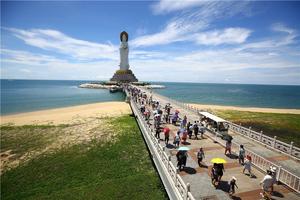 Visitors tour the Nanshan scenic area in Hainan's Sanya. (PHOTO PROVIDED TO CHINA DAILY)
Visitors tour the Nanshan scenic area in Hainan's Sanya. (PHOTO PROVIDED TO CHINA DAILY)
Travel within the mainland has returned to normal with pandemic controls, says Peng Liang, a researcher with Trip.com Group's big data lab. And the recovery has also boosted domestic travelers' confidence.
"Smooth tourism-market operation over the past few weeks will help build momentum for the travel boom during the long National Day holiday," Peng says.
The repressed desire to travel has been simmering for months.
"Bookings for the holiday reached 65 percent by early September," says Wang Zuoquan, an official with Beijing's Wtown resort.
The resort has seen daily visitor numbers exceed 10,000 since August, and hotel-room bookings have often exceeded the same period of last year, Wang says.
"Family travelers have significantly increased. Individual spending is rising. And guests are staying longer," Wang says.
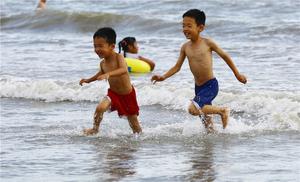 Children play at the seaside on Hainan Island. (PHOTO PROVIDED TO CHINA DAILY)
Children play at the seaside on Hainan Island. (PHOTO PROVIDED TO CHINA DAILY)
Wtown has kept up sanitation, and offers online payments and audio guides.
Wang expects guest numbers to peak during the October holiday.
"They can enjoy the stunning autumn views of colorful leaves and enjoy hot springs," Wang says.
Last year, domestic destinations received 782 million visits during the seven-day National Day holiday and raked in nearly 650 billion yuan (US$95 billion) in tourism income.
Tourism players are counting on the holiday to make up for the losses caused by the pandemic and have developed favorable policies to boost consumption.
Xinjiang's Kashgar is offering free access to all of its A-level scenic spots, discounts for its star-rated hotels and incentives for travelers who drive themselves, which will remain in effect until year-end.
Central China's Hubei province and East China's Shandong province have also opened A-level attractions to the public for free.
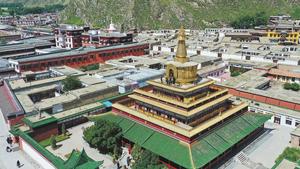 A Tibetan Buddhist temple in Shambhala. (PHOTO PROVIDED TO CHINA DAILY)
A Tibetan Buddhist temple in Shambhala. (PHOTO PROVIDED TO CHINA DAILY)
Jiangsu province's Suzhou recently rolled out 1 yuan tickets for any one of its 14 celebrated gardens.
Alibaba Group's online travel arm, Fliggy, has initiated a 10 million yuan subsidy program to boost the recovery.
The program covers tens of thousands of hotels across the country, as well as transportation, scenic spots and theme parks.
During the second week of September, hotel bookings for the National Day holiday surged by 190 percent over the previous week, according to Fliggy, and air ticket sales increased by 160 percent.
Although hotel costs have increased by 65 percent on average during the holiday compared with the summer vacation period in August, they're still 30 percent lower than during last year's National Day holiday, according to Fliggy.
High-speed train tickets to many destinations, such as Harbin in Northeast China's Heilongjiang province and Changsha in Central China's Hunan province, for the first day of the National Day holiday were quickly snapped up after sales resumed in early September, according to the country's railway ticket-booking website, 12306.cn.
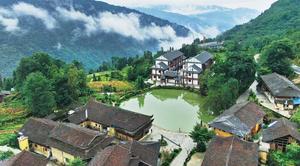 A mountainous village in Chongqing's Wulong district. (PHOTO PROVIDED TO CHINA DAILY)
A mountainous village in Chongqing's Wulong district. (PHOTO PROVIDED TO CHINA DAILY)
More tourists are expected to choose small tours or drive themselves.
The pandemic has enhanced people's safety awareness, and private tours can better satisfy their needs by decreasing unnecessary contact and better ensuring hygiene, says Yu Dan, who runs private-tour operations at Trip.com.
Flexible arrangements and better on-tour services also enhance the popularity of small private tours, Yu says.
Travelers who drive themselves accounted for about 30 percent of tourists during last year's National Day holiday. The figure is expected to increase this year out of precaution, according to Trip.com.
Hainan, Yunnan, Sichuan and Shaanxi provinces are expected to be hot spots during the holiday, Peng says.
Hainan is likely to remain popular thanks to its island and leisure elements, and duty-free shopping, especially since the pandemic continues to stunt outbound travel, Peng says.
Hainan's Sanya tops the list of Trip.com's bookings.
The province's Haikou Meilan International Airport will add or resume more than 1,500 flights to meet the surge during the October holidays.
 Tourists pose for pictures at Chaka Salk Lake. (PHOTO PROVIDED TO CHINA DAILY)
Tourists pose for pictures at Chaka Salk Lake. (PHOTO PROVIDED TO CHINA DAILY)
About 1,350 flights are expected to be added to connect Haikou with major tourist cities, including Shanghai, Guangdong province's Guangzhou and Shenzhen, and Hubei province's Wuhan. Meanwhile, about 180 flights are scheduled to resume, the airport says.
Chongqing, Shaanxi province's capital, Xi'an, Yunnan province's capital, Kunming, and Zhejiang province's capital, Hangzhou, are expected to be favorites of tourists planning trips lasting three to five days, Peng predicts.
Northwestern destinations also stand out among searches.
The early September, searches for travel products in Northwest China surged by 475 percent month-on-month, Trip.com reports.
The Tibet and Xinjiang Uygur autonomous regions, and Qinghai and Gansu provinces topped the search list and were especially favored by tourists from Shanghai and Guangdong.
Deserts, camel rides, danxia landforms and historical sites along the Silk Road are among the biggest draws for northwestern China, the agency says.
Most travelers are looking at five-day interprovincial trips in the region.
Groups of friends and families are major forces behind bookings for the holiday, as college students account for a diminishing proportion.
It's yet to be announced whether they can leave their campuses to travel, which will significantly affect tourism during the holiday, Peng says.
Chen Mengyun plans to visit Tibet with friends.
"We'll fly to Lhasa and then rent a car to travel around the region," the Beijing resident says.
It'll be her first trip outside of Beijing since the outbreak.
Chen says their rough itinerary has been settled, and they'll make it a point to visit temples and historical sites.
"The idea of going out with my friends is exciting," she says.
"We've been looking forward to traveling together for a long time."
Contact the writer at yangfeiyue@chinadaily.com.cn


